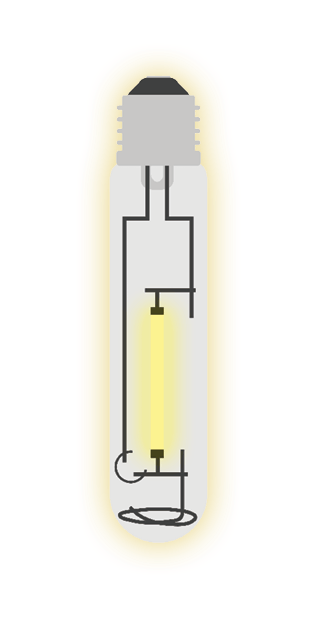
Designing a lighting plan for a cannabis crop might be easier if there were a reliable rubric. Of course, there is no such thing in an industry where business goals and growing conditions vary widely from one grower to the next — and even from room to room within a cultivation facility.
In fact, the only universal lighting rule may be this: Respect your growing space and all the elements in it. “You want to design your room around ceiling height, spacing, amperage, desired spectrum of light and everything available to you in that room,” says Emily Walter, sales manager for Nanolux Technology, a California-based company that manufactures lighting for the horticulture and hydroponic industries.
Many growers are aware that choosing one lighting fixture over another can double (or halve) their power requirements and have huge implications for their crops and their businesses. That’s why many growers tap commercial lighting companies to help them find custom solutions.
A custom design calculates how much — and what kind — of light a plant will get with a certain grid design. For example, if a grower wants to use double-ended and ceramic metal halides in a checkboard pattern to create a dual-spectrum light, Nanolux can enter that into a program and provide the value outputs, says Walter.
Growers use detailed lighting plans to achieve precise goals and anticipate performance before lighting is installed, says Chuck Demilo, vice president of marketing for LED-grow-light manufacturer Transcend Lighting. “When a grower defines a PPFD (photosynthetic photon flux density) requirement, that metric should be met uniformly over the entire canopy,” he says. Since no two layouts are identical, a custom lighting plan may be intricate, but Demilo says growers shouldn’t rush to purchase lighting before analyzing results from a lighting plan.
Lighting vendors are most helpful when they meet growers with clear priorities, such as a desire for yield, energy efficiency or certain traits in the end product, including high THC, specific terpene profiles or longer shelf life.
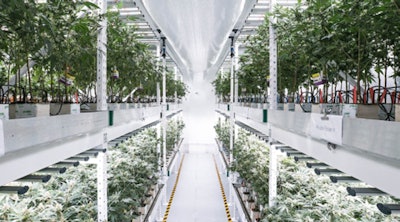
Despite differences in certain goals, most growers have one thing in common: They want the highest-quality, maximum-yield crop for the lowest cost. Regardless of the circumstances, every grow room can be optimized with a custom solution, according to Rami Vardi, founder and CEO of Spectrum King LED Inc., which manufactures full-spectrum LED lights. For example, Spectrum King has a client that uses high-wattage lamps, delivering extra heat in a cold climate. To save energy, Spectrum King designed LEDs that run hot and last up to five times longer than traditional bulbs, says Vardi.
Many lighting mistakes can be avoided by shopping with established companies known for customer service, suggests Walter. Some lighting companies even have resources to help growers calculate the impact of any eligible energy rebates and satisfy administrative requirements. “I’ve been in this market space for 11 years now, and I’ve seen new lighting companies come out of nowhere,” Walter says. Sometimes they only last a few years, leaving growers empty-handed when they need support, she says.
When talking with lighting companies, many growers are tight-lipped about their cultivation techniques, but the gateway to better lighting decisions is marked by openness. “Lighting is such a nuanced and complex topic,” says Travis Williams, vice president of marketing at Fluence Bioengineering, which manufactures commercial horticulture grow lights. “The impact it has on the crop and the business may not be fully understood until we really engage with customers. That’s when we can dive in and help clients maximize revenue per square foot, increase the yield or meet some quality metric they are striving for.”
Once growers choose a lighting system, they’re in a better position to optimize other facets, such as HVAC systems, table layouts or plant flow processes. Williams says the sooner growers involve a reputable lighting vendor in their research, the better off they’ll be.
Lighting 101: A Grower’s Guide to Lighting Metrics
No one wants to be a pawn in someone’s marketing game. What’s the best way to avoid that trap when purchasing lighting for a commercial cannabis business? Master the evaluation process. “Education is so key in this space,” says Williams.
Williams says growers can improve the way they buy and use lighting by learning how these four lighting metrics affect their cultivation goals:
1. Photosynthetic Photon Flux (PPF). PPF measures (in micromoles per second) how many photons a lighting fixture emits. When growers buy a lighting system, they’re buying photons. If they don’t know a system’s PPF, they don’t know how many photons they’re buying. A reputable lighting company has a third party measure their products for PPF. Those values are published on product information.
2. Photosynthetic Photon Flux Density (PPFD). When growers hang a light, they want all the photons they can get on their plants. Any light that goes elsewhere is wasted. The amount of light on their canopy is the PPFD. It’s one of the best metrics for determining how much light they’re buying or using. Measuring PPFD can be accomplished in the garden with a quantum meter, and can be complicated, but a reputable lighting company can work with growers to develop a lighting design before installation to determine how much light will be delivered to the canopy.
_fmt.png?auto=format%2Ccompress&fit=max&q=70&w=400)
3. Spectrum of light. PPF and PPFD are important, but they don’t reveal anything about the light type, quality or spectrum. These traits can vary widely from one form of lighting to the next, and they have a significant impact on crop development. As humans, we see light in lumens, but plants react to PAR (photosynthetic active radiation). PAR is the range of light plants use in photosynthesis.
According to horticultural research, plants only use light between 400 and 700 nanometers for photosynthesis. Growers need to understand the spectral graph of the light and how those wavelengths affect various photoreceptors in plants.
It’s not a simple topic, but most people can learn enough in a one-hour lesson to ask the right questions about lighting.
4. Energy efficiency. Energy efficiency measures how much light is emitted for every electron (measured in watts) coming into the fixture. Think of this metric as “miles-per-gallon” for light. The higher the number of micromoles per joule, the greater the energy efficiency.
The key to using these metrics effectively is to study them together and decide what makes sense for a particular business model.
“There are a few lighting systems on the market that have high energy-efficiency levels, but they have extremely low light output or a narrow spectrum of light that is almost all red,” Williams says. “Cannabis requires a lot of light to thrive, so you can’t just buy lighting based on an energy-efficiency metric. Conversely, you can’t just buy off of a PPF metric because that doesn’t tell you the quality of light and where the light is delivered. There isn’t a silver bullet to qualify or quantify ‘the best’ lighting fixture. It’s multi-faceted and dependent on the crop, cultivation environment and business objectives.”
17 Lighting System Design Tips
Every cultivator hopes to crack the code that reveals a perfect recipe for growing cannabis. Although there is a constantly growing body of horticultural science about what works and what doesn’t, most of it does not pertain to cannabis. Since lighting products depend on innovation, the industry’s manufacturers are great resources for documenting field experience and supporting academic research that shapes the way lighting is made. Here, you’ll find tips that could influence how you select and use lighting.
Tips … from Ryan Wankel, grower liaison for Heliospectra
1. Buy a good light meter. “It’s important to know which spectrum you are delivering to a plant. A good light meter is a valuable tool for making technical decisions or planning a grow room. The best light meters read PAR in micromoles of light and measure the spectral graph.”
2. Incorporate spectrum control. “Recent innovations give growers access to lighting systems that offer full spectrum control, taking them one step closer to a truly optimal grow. If you want to explore secondary metabolites in your plants, then spectrum control should be intriguing to you. These systems mimic nature’s transitions, allowing you to deliver blue light during vegging and red light later. They [have the potential to] create a healthier plant because they deliver the right light at the right time.”
Tips … from Michiel de Jong, sales manager, Lemnis Oreon
3. Take a holistic approach. “Lighting for plants always needs to be followed with the right temperature, humidity, CO2 level and more. For instance, the Oreon Grow Light is water-cooled so growers can control light levels independently from temperature influence. This can reduce necessary investments in HVAC systems by up to 70 percent.”
4. Think like a plant. “Don’t think like a human with human eyes, but try to think like a plant. We have spent a lot of time finding out how plants work and what that means for our lighting fixtures. The growing cannabis industry will benefit if plant physiology becomes the basis of growers’ facility and lighting designs.”
Tips … from Joseph Lamendola, senior plant scientist, Illumitex
5. Understand cultivation methods and facility capabilities while considering which lighting solutions to buy. “Lighting systems carry the burden of being one of the largest capital expenditures for grow operations. Choosing a system before [without considering] grow methods and systems can result in incorrect fixture selection and lighting levels. Having a clear understanding of the process flow will ensure the appropriate lighting metrics are targeted and delivered to the crop.”
6. Strive for the highest level of spectrum and intensity uniformity. “Variation in spectra and intensities can cause significant changes in the crop physiology, growth rates and overall plant health. This stratification adds unnecessary complications to production as it requires management of individual plants. Achieving a high degree of uniformity over the plant canopy will result in uniform growth patterns and allow a more holistic operational management strategy.”
Tips … from Eric Harrington, commercial accounts manager, California Lightworks
7. Fill a room with canopy. “Filling a room with canopy is an increasingly popular approach to organizing plants in a commercial cannabis grow. You can do it with big plants that allow you to work without dedicated aisles, or with movable trays that keep one (moving) aisle free.
In these designs, lights are mounted 4 feet or more above the canopy, reducing light loss from aisle space. This layout gives more consistent light everywhere in the room. The only loss occurs from small amounts absorbed by the walls.” (Note: California Lightworks is an LED-grow-light manufacturer, so this tip is in reference to LEDs.)
8. Simplify mounting height. “If a light is powerful enough to handle a 4-[foot] by 4-[foot] section of canopy, and it produces a 4-by-4 footprint at 24 inches above the canopy (which is the case with our 650-watt light), then raising the light to 4 feet above the canopy increases the footprint to 8 by 8 — an area large enough to overlap the center of the 4-by-4 areas on all four sides [when mounted next to adjacent fixtures]. It creates diffused, shadowless light from above and all four sides.”
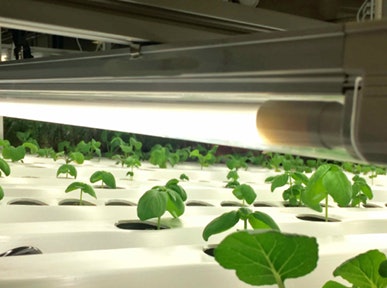
Tips … from Jeff Gasman, CEO, Pro MAX Grow
9. Involve an interior cultivation consultant. “A good cultivation consultant understands spectral output and has a professionally calibrated spectrometer to evaluate three things: One, how much light your fixtures produce; two, how much light is available to the plants; and three, how much light the plants receive each day. Once you know those things, you can make a successful lighting plan.”
10. Look for lighting solutions that are compatible with vertical cultivation. “Growers can maximize space by stacking plants vertically and utilizing a top-down watering system. In this high-water environment,” he suggests, look for lighting options that are safe and designed for top-down watering environments.
Tips … from Jeff Fenley, CEO, Powerbox
11. Choose lighting that suits your environment. “[A] prominent trend over the last few years has been greenhouse-style lighting or ‘combination’ fixtures that combine the ballast and lamp in one unit. These fixtures were originally designed as supplemental lighting for greenhouse use, but many cannabis growers have adopted them for indoor use. They have a high output, so it is important to have very high ceilings. Some growers don’t recognize this until it’s too late.The results are not good when growers try to use these fixtures in environments with ceiling heights of 8 to 10 feet. Growth becomes stunted and the plants get burned.
If your environment has ceiling heights of less than 12 feet, stick with traditional lighting fixtures that don’t require as much distance between the plant canopy and the fixture.”
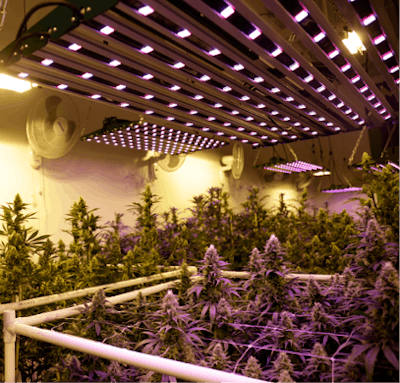
Tips … from Neil Yorio, vice president lighting research, BIOS Lighting
12. Pay attention to performance data. “LEDs have improved dramatically in recent years. They are becoming much more common in cannabis operations, but results are very dependent upon the design and an accurate description of the fixture’s performance. Some LED products have the same problem found in HPS fixtures — hot spots of light. LEDs can be positioned inches above the canopy and spread light over a large area to minimize this issue, but an LED in a lower position isn’t always a panacea. Fixtures located close to the canopy can interfere with air movement around the top layer of leaves. ... Stagnant air can have an adverse effect on plant growth and increase the chance of disease and insects.”
Tips … from Eric Moody, USA lighting solutions specialist, PL Light Systems
13. Aim for uniformity. “Everything you do in your grow can be effected by how uniform your lighting is. Irrigation, fertilizers, etc., can all be affected by how your crop receives light. If your lighting is not uniform then areas with more light will use water, fertilizers, etc., faster than areas with less light. This can cause your crop to not only grow at different rates, but can cause drying in some areas or battling the wetness that leads to mildew in others.”
14. Determine the right light level for large-scale operations. “What light level are you comfortable growing under and how do you determine that? The cannabis world (especially indoor growers) likes to throw out a micromole number as a target. Usually between 800 to 1000 µmols (micromoles). While that is accurate, we need to understand why.
A micromole is one millionth of a mole and is an accumulation of photons measured over a square meter per second. ...
The challenge with cannabis (and there are many other crops like this) is that to encourage flowering, you also need 12 hours of darkness. This means you need to accumulate your total moles ... over 12 hours.
While this is a great target number, lighting is only part of the equation of a healthy crop. I see ... growers who have years and years of experience growing in a small room with air-cooled hoods and most likely a lower light level, but produce a great product. They are then launched into the opportunity to start growing in a large commercial facility designed to have a uniform light level of 900 under 1000w double-ended high-pressure sodium (HPS), and they struggle because now their crop is using more fertilizer, more CO2 and is drying out faster.
Growers need to rethink their entire grow systems when they move into a large commercial grow.
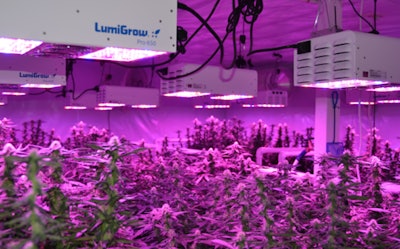
Work under a light level they are comfortable with, but keep in mind that too low a light level will result in a lighter, airy bud without the weight they might want.”
15. Consider light levels carefully when transitioning plants from one growth stage to the next. “Light levels between veg rooms and flower rooms are equally important. If you move your crop from a low-light-level veg room into a high-light flower room, you could risk sending the crop into shock. This will not happen right away, but can show up one to two weeks after moving into flower.
A good rule of thumb is to not have a light level more than double from veg to flower. [For example,] 450 µmol in veg then no more than 900 into flower.”
Tips from Brandon Newkirk, marketing manager, LumiGrow, Inc.
16. Consider your total return on investment (ROI). “There’s more to consider when calculating ROI of your lighting fixtures than just the amount of light [reaching] your canopy.
Cannabis cultivation has traditionally consumed massive amounts of power. ... This high demand for energy represents significant cost. ...
When choosing a lighting solution, it’s important to look at both power and heat output, then weigh these numbers against energy costs. ...
Remember that much of your HVAC costs come from compensating for heat from your lights. Lower ambient temperatures mean less demand from your HVAC.”
17. Take advantage of modern technology. “Scientists have made leaps and bounds in the way we understand how plants use light. PAR refers to the spectrum of wavelengths that have the highest capacity to drive photosynthesis. Some light fixtures take advantage of this phenomenon and target their output to maximize photosynthetic efficiency.
We’re also seeing that different wavelengths of light can be used to influence plant characteristics. Using available information about how various strains respond to light spectra, you have the potential to further refine your lighting strategy for maximum yield and quality. Light spectra can influence rate of growth, flowering times, and terpene and cannabinoid production.
Another important piece of tech to keep handy is a quality PAR meter to measure the effectiveness of your lighting layout, no matter how advanced your configuration is. Good light uniformity means a more uniform crop production, and wasted light equals wasted money. By measuring the performance of your lighting layout, you can continue to advance and improve your strategy to realize even greater returns.
It can appear daunting when planning your lighting strategy, but if you utilize the myriad resources available by industry lighting professionals, you’ll be up and running with an efficient lighting strategy in no time. It’s to your advantage to be discerning when comparing lighting fixture specs and performance. With more data readily available than ever before, keeping a holistic mindset when approaching your production strategy will help your business to maximize it’s bottom-line, and lighting is one of your best tools for getting there."
















